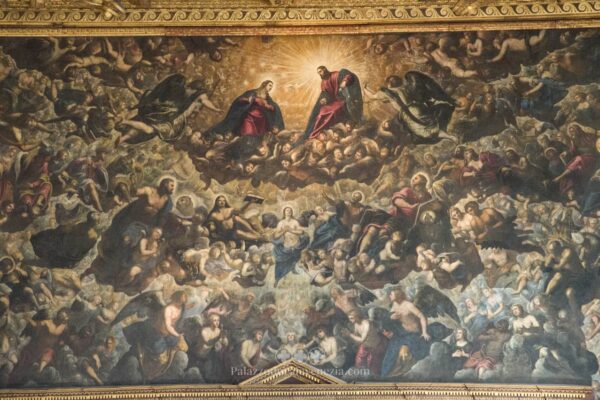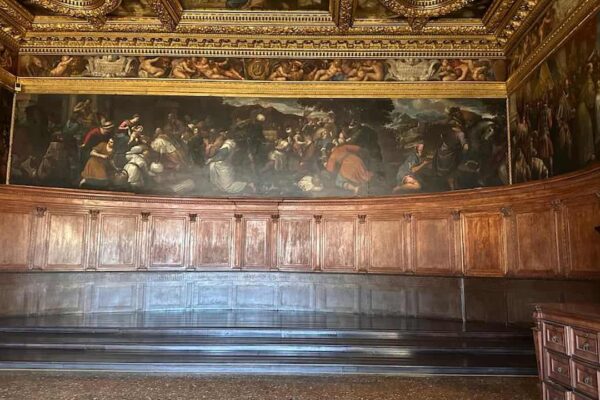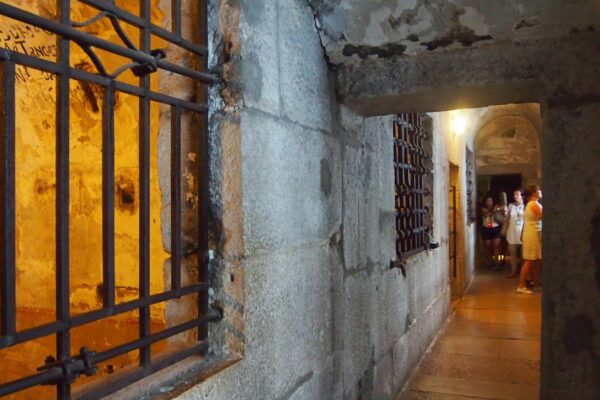Would you like more information about the inner courtyard of the Doge’s Palace Venice?
In this article I will describe the architecture of the facades of this marvellous courtyard, and the two main works you will encounter as you enter and begin your visit to the interior of the Palace: the Porta della Carta and the Scala dei Giganti (Giants’ Staircase).
Are you ready? Let’s get started!
Before we begin, a brief preamble: if you plan to visit the Doge’s Palace in Venice, the courtyard, the halls and all the other rooms, it is strongly recommended that you buy your ticket online, because of the long queue that may form at the ticket office. By purchasing your ticket in advance, you will be able to enter the Doge’s Palace skipping the queue.
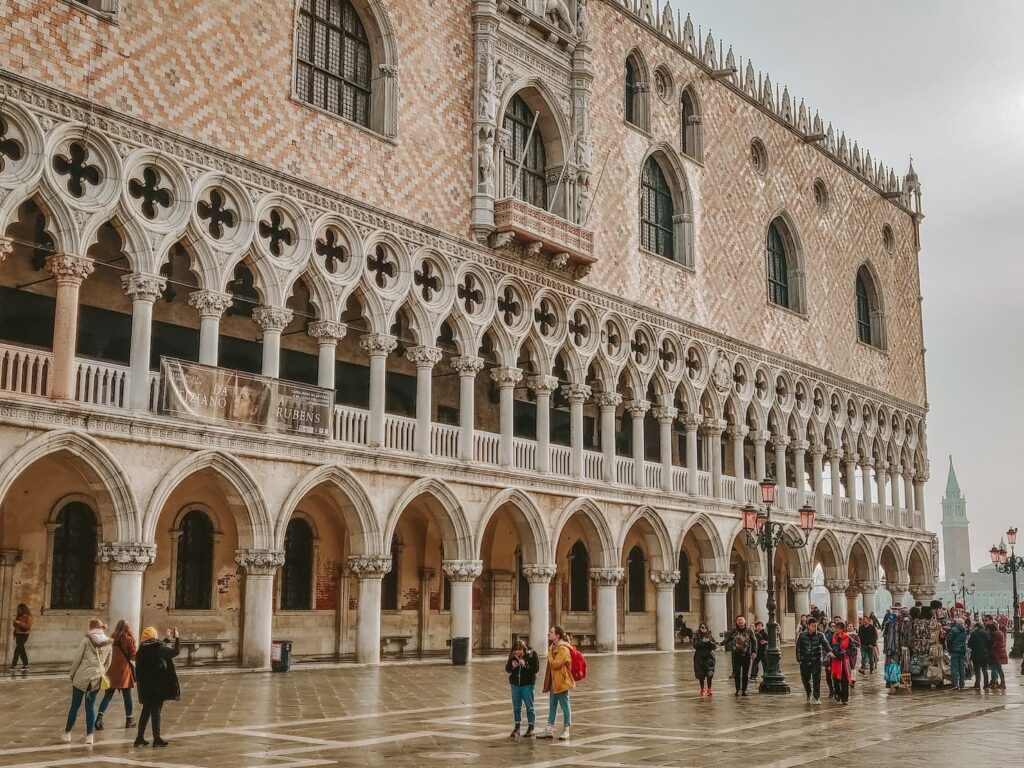
Doge’s Palace Venice skip-the-line ticket: quick access
Buy online. Choose your preferred time. Visit Venice’s Doge’s Palace, Bridge of Sighs, prisons and more.
You can cancel for free up to the day before your visit.
Table of content
The courtyard of the Doge’s Palace in Venice
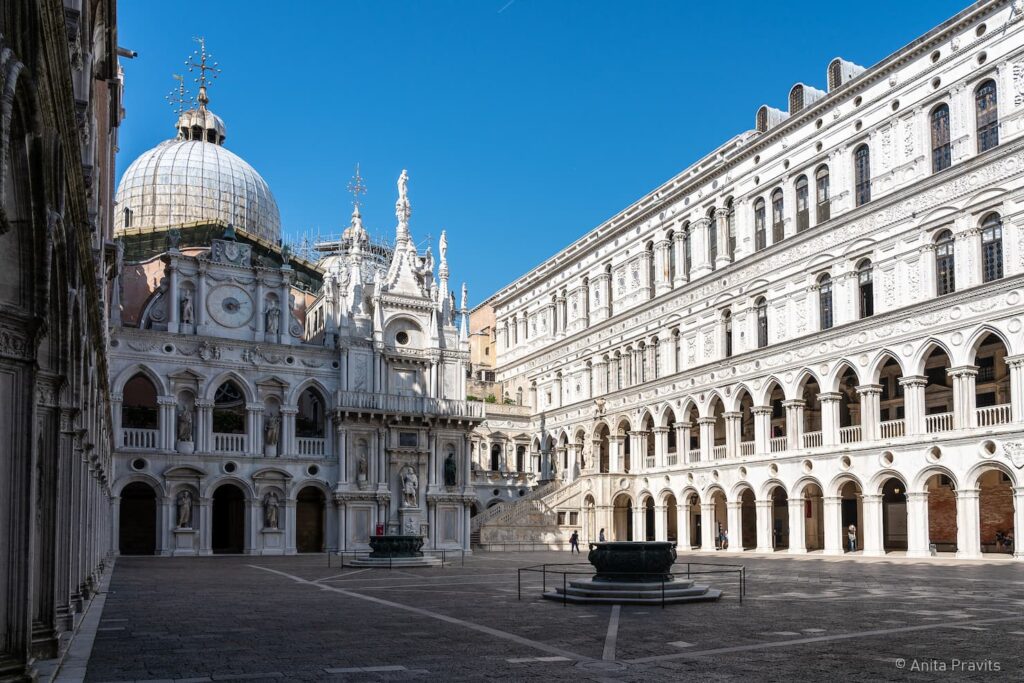
Passing through the Porta della Carta, you will find yourself inside the courtyard of the Doge’s Palace. This space is surrounded by porticoes and loggias, and you will notice that it is not uniform in style. In fact, its current conformation is the result of numerous building interventions over the course of four centuries, from the mid-14th century to the early 17th century.
The courtyard is rectangular in shape and the main Venetian ceremonies, including tournaments and the coronation of the doge, took place in it.
In the center of the courtyard are two bronze wells, unique for the richness of their decoration. They bear bas-reliefs with sacred water-related scenes: Jonah rejected by the whale and the Miracle of the Wedding at Cana.
The courtyard of the Ducal Palace was open and accessible to the population, who could use the two large public wells.
The facades
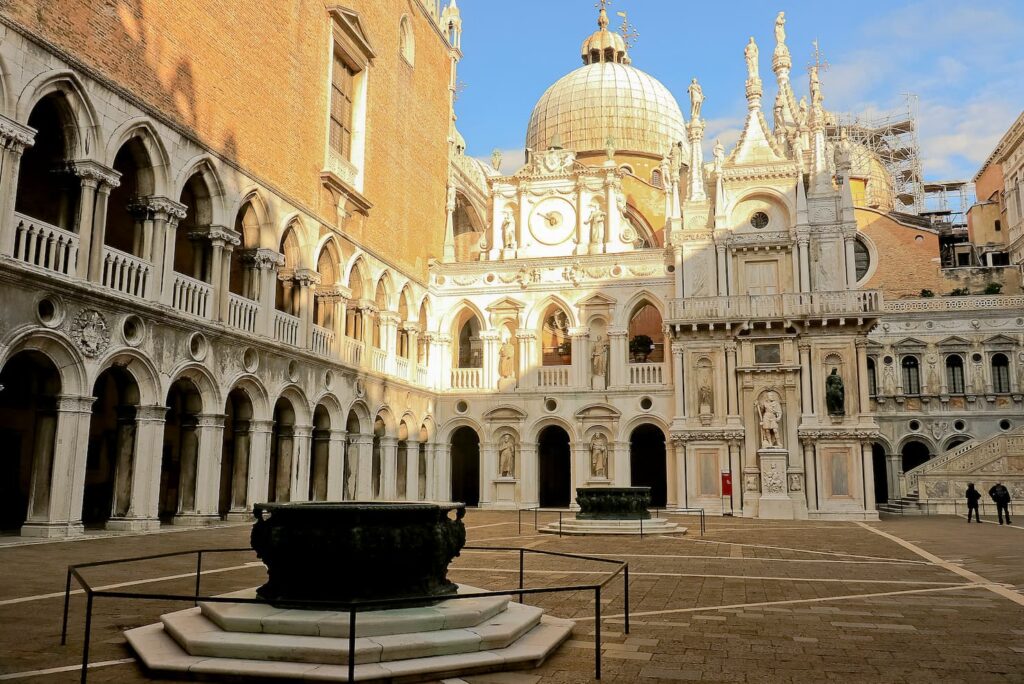
Now I suggest you pause to look at the inner facades of the courtyard:
- The south facade facing St Mark’s basin and overlooked by the Hall of the Great Council is the oldest. Work on its construction was completed in 1340. The style is typically Gothic, with ogival arches and long porticoes on two floors, among which the splendid Loggia Foscara will catch your eye. The last band has a brick face surmounted by pinnacles and is occupied by three large windows, which, together with those on the west facade, were opened in the 16th century.
- The west facade, overlooked by the Hall of the Scrutiny, is also Gothic in style and was built from 1424 onwards. It houses the Porta della Carta and the Foscari hallway. The keystones of the latter are carved with images of the Evangelists. Work on the covered passage and arch was commissioned by Doge Francesco Foscari. The front is composed of alternating bands of Istrian stone and red Verona marble.
- The east facade, in Istrian stone, has a Renaissance style and houses the monumental 15th-century Giants’ Staircase on the left side. The facade has four orders of pilasters, columns and reliefs, the work of the Lombardo brothers. The portico is cadenced by the rhythmic succession of windows. There are sculpted panels and roundels in porphyry, festoons, grotesques, spirals, and arms that stand out against the marble facade. On the pilasters are the coats of arms and initials of the Doges Marco and Agostino Barbanigo and Francesco Donà. At the top of the grand staircase, designed by Antonio Rizzo, are the colossal marble statues of Mars and Neptune, gods of war and the sea respectively, by Jacopo Sansovino, who made them in 1566.
- The north facade, towards St Mark’s Basilica, is occupied by the Baroque facade of the Clock, part of Bartolomeo Manopola‘s architectural design. On the clock is carved the date of completion, 1615. Beneath it are two Roman statues from the Grimani collection. Part of the facade is occupied by the Church of San Nicolò, closing off the Senators’ Courtyard behind it, where magistrates waited for meetings to begin.
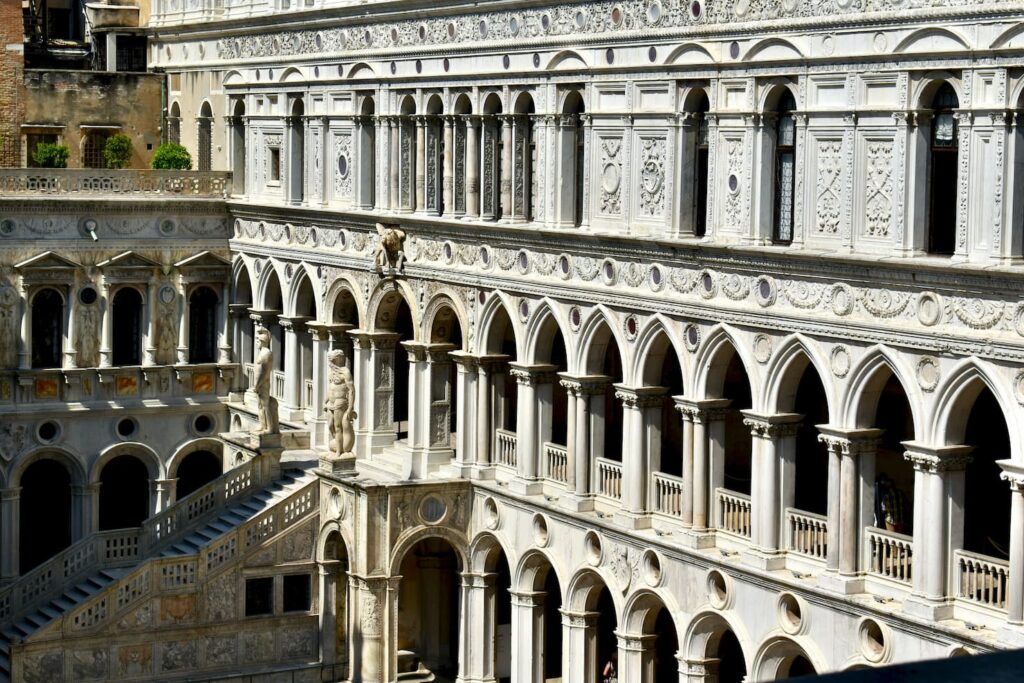
Doge’s Palace Venice skip-the-line ticket: quick access
Buy online. Choose your preferred time. Visit Venice’s Doge’s Palace, Bridge of Sighs, prisons and more.
You can cancel for free up to the day before your visit.
The Porta della Carta
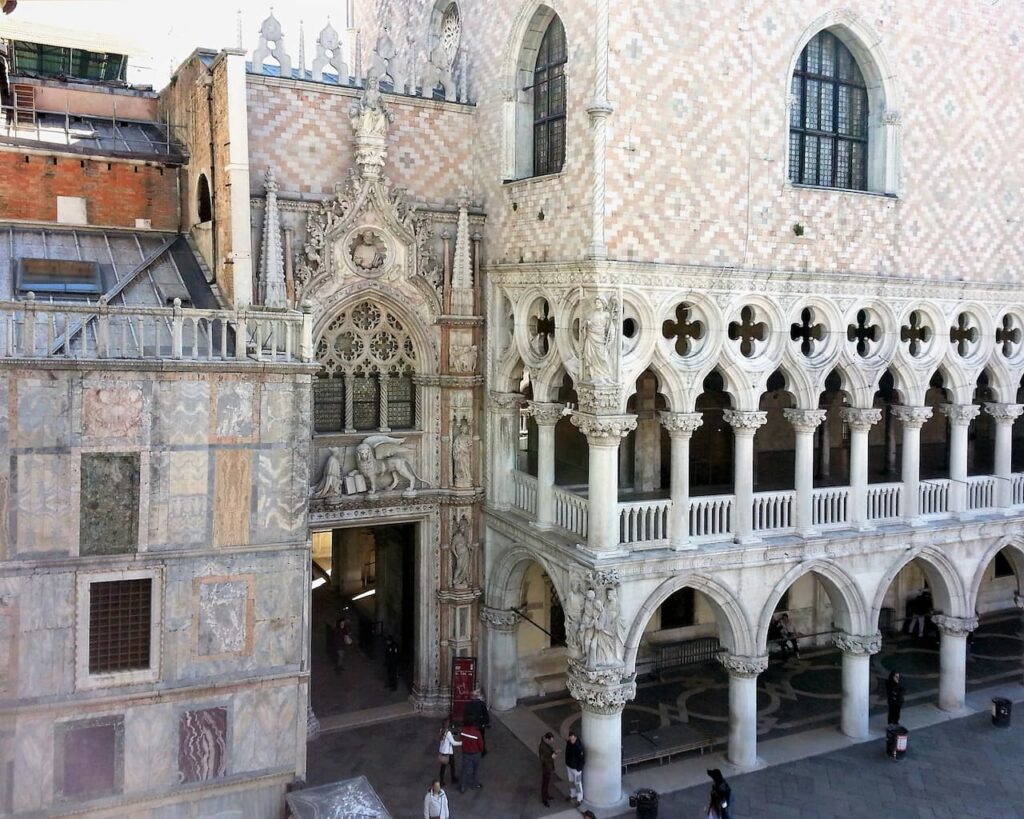
The access to the courtyard is through the majestic Porta della Carta.
The history of this door dates back to the 15th century, when it was designed by Renaissance architect Bartolomeo Bon, who together with his father was commissioned to carry out some of the decorations in the Palace.
The door takes its name from the practice that took place inside: here, the palace’s administrative officials would check, approve, and register paper documents, hence the term ‘carta’ (paper).
Architecturally, the Porta della Carta is a perfect example of the Venetian Renaissance. It is made of white marble from Istria and is framed by two pilasters decorated with niches, sculptures, bas-reliefs, and pinnacles. Above the portal is a three-mullioned window decorated with sculptures. The door itself is decorated with bas-reliefs depicting mythological and allegorical scenes, executed by numerous sculptors of the time.
Above the door is a statue of Justice, symbolizing the proper exercise of laws and justice within the ducal palace. Below is a stucco depicting St. Mark flanked by two angels.
The large three-mullioned window on the first floor with the sculptures of the Marcian lion and the doge at the base features bottle-bottomed glass obtained by a special blowing technique that allowed for perfectly circular shapes.
The statue of the doge Foscari and the lion, which stands under the window, was destroyed in 1797, when the French occupied Venice in an attempt to wipe out anything that might still remind one of the splendor of the lagoon city, and was later rebuilt in the 19th century.
On either side of the Porta, inside niches, are four sculptures: Charity, Prudence, Fortitude and Temperance.
The Porta della Carta played a fundamental role in the administrative and public life of Venice and was the main entrance to the administrative offices of the Doge’s Palace. Today, the gate is still used to access the palace.
The Giants’ Staircase
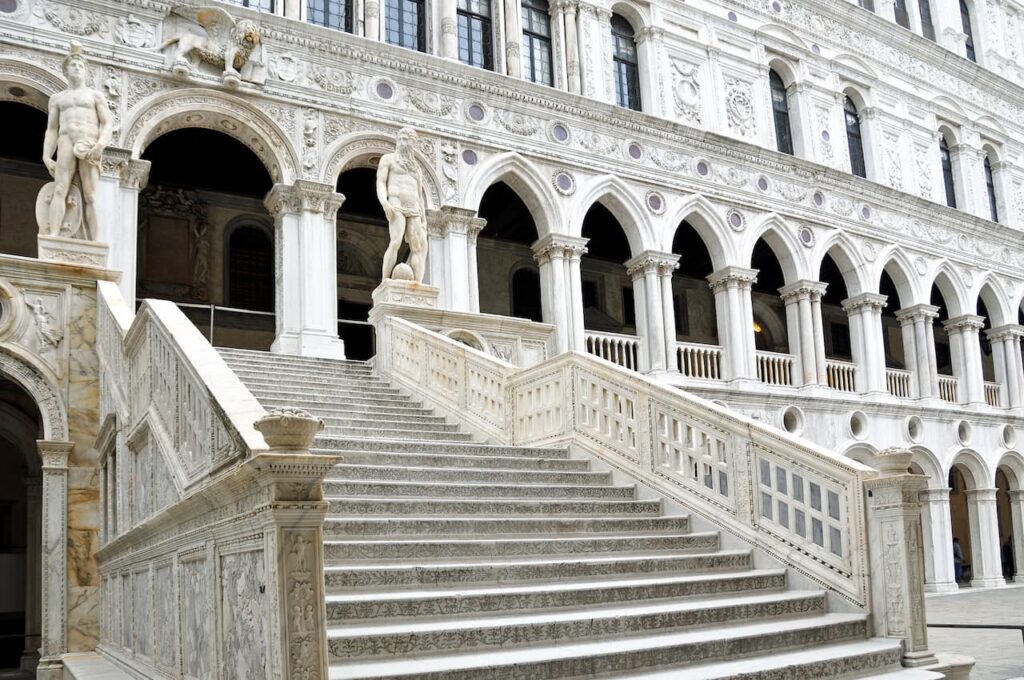
This magnificent staircase is located at the main entrance to the palace and is an outstanding example of Venetian Renaissance architecture.
This is where the ceremony was held to celebrate the investiture of the doge, during which the nominee swore allegiance to the Republic to the head of the Council of Ten, the highest office after the Doge. During the celebration the new dux in office received the zoia and the Doge’s Horn, the headgear he had to wear in civil and religious events. He had to position himself on the plane at the top of the staircase so as to be visible from every point in the palace courtyard and surrounding loggias.
The staircase was built in the 16th century by architect Antonio Rizzo, who also designed the nearby Arco Foscari.
The architecture of the staircase is characterized by a magnificent entrance portal, with decorated columns and capitals, that opens onto a double flight of steps. The steps are made of white Carrara marble and feature elaborate motifs reminiscent of classical art.
The staircase takes its name from the two monumental sculptures by Sansovino that guard it on either side. These imposing statues depict the Greek god Neptune and Mars, the Roman god of war. The statues are monumental in size and give the staircase a majestic and imposing presence. It seems that the mastodontic dimensions were commissioned precisely to diminish the figure of the Doge at the moment of his coronation, reminding him of his role as a servant of the Republic.
The staircase continues with its ramps inside the palace, taking the name Scala d’Oro (Golden Staircase) for its gilded stucco ornamentation. Of its five flights, the first is dedicated to the goddess Venus, while the one leading to the doge’s flat is dedicated to Neptune, symbol of Venice’s dominion over the sea.
Conclusions
Here we are at the end of this in-depth look at the courtyard of the Doge’s Palace. If you have any further doubts or curiosities, write to me, I will be happy to answer you!
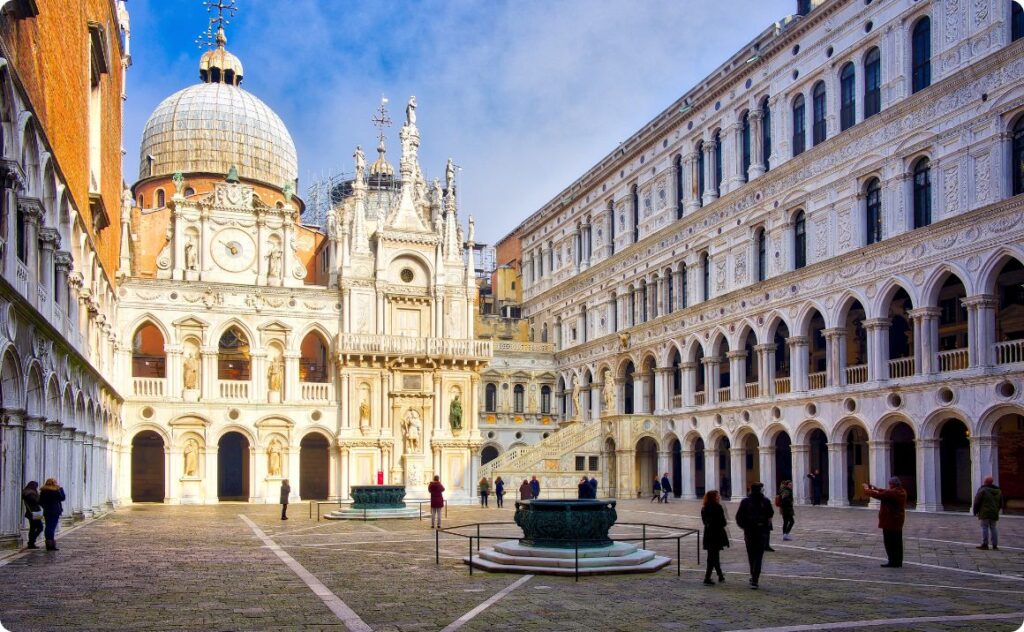
Doge’s Palace Venice skip-the-line ticket: quick access
Buy online. Choose your preferred time. Visit Venice’s Doge’s Palace, Bridge of Sighs, prisons and more.
You can cancel for free up to the day before your visit.
Photo credits:
- Courtyard of Doges’ Palace: Photo by Anita Pravits via Flickr
- Courtyard of the Doge’s Palace: Photo by Michael McBride via Flickr
- Paper Door: Photo by Slices of Light via Flickr
- Stairway of the Giants: Photo by Dennis Jarvis via Flickr
